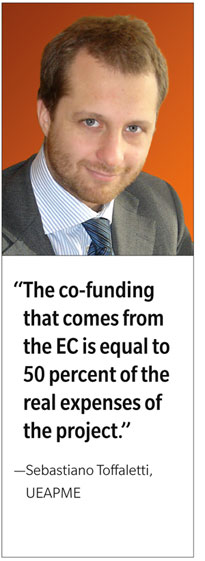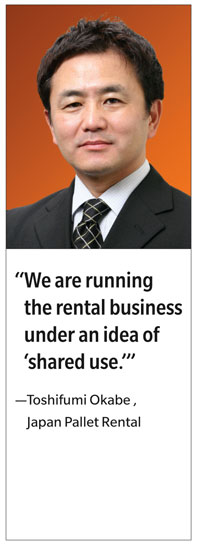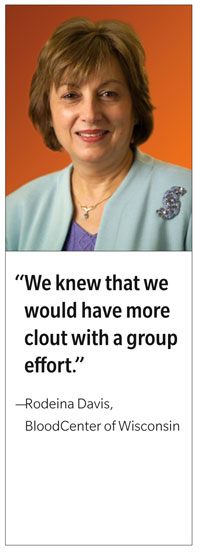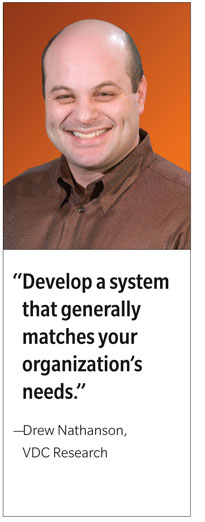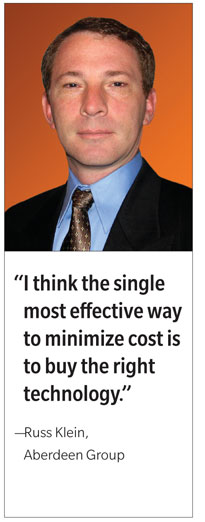Aug 01, 2010Darren Brookes, operations director of Sovereign Security, a security service in Nottingham, England, wanted to develop a radio frequency identification system that could pinpoint the location of guards patrolling a university campus, business site, recreation center or other public area to meet client and regulatory needs. "If one of my officers doesn't patrol at the right time, or arrives late onto a site, or doesn't do a particular task he's been asked to do, the client would be able to see that," Brookes says.
But while the idea sounded great, money was tight. Facing the challenge of creating an important business-enhancing service without a substantial budget, Brookes began working on an alternate funding strategy. After some basic research—and discussing the situation with RFID systems developer Sero Solutions of Birmingham, England, and UEAPME, the European Association of Craft, Small and Medium-sized Enterprises—Brookes discovered a government program that would cover up to 50 percent of the project's cost. The result? Sovereign's RFID system is scheduled for deployment next year.
Like many other organizations interested in deploying RFID in a uniquely challenging economic environment, Brookes decided to think creatively to find a way to finance a vital system at a fraction of its projected cost. Looking to cut sharp deals on RFID equipment, software and services, companies worldwide are investigating government grants, technology leasing, business partnerships and other strategies designed to get their RFID projects off the ground without breaking the bank. "It's a time when businesses are really being forced into thinking smarter," says Russ Klein, an RFID industry analyst at Aberdeen Group, a Boston-based technology research firm.
1. Seek Government Help
For Sovereign, government help meant the difference between having a state-of-the-art RFID tracking system and continuing to use a far more basic system that required site visits to retrieve a portable device for desktop syncing. The company is hardly the only business in Britain, or Europe, to have received RFID development assistance from a government organization. In fact, over the past several years, the European Union (EU), through the European Commission (EC), has funded scores of RFID projects across diverse industries.
In Sovereign's case, the funding source was an EC program, RFID-ROI-SME, designed to promote RFID's use among small and midsize businesses. "The EC recognized that RFID technology has great potential, especially for small and medium enterprises, and that not enough of these enterprises were actually using this technology even though they could have an economic benefit," says Sebastiano Toffaletti, UEAPME's senior project manager. "The co-funding that comes from the EC is equal to 50 percent of the real expenses of the project, which means all the [recipients] involved in the project are financing out of [their] pockets the remaining 50 percent."
Excel Manufacturing, which produces battle dress uniforms for the U.S. Air Force, was able to get the Defense Logistics Agency (DLA) to cover most of the cost of an RFID system Excel developed to monitor inventory levels and track outgoing shipments. "The DLA covered the hardware cost for us, which was the biggest part of [the project]," says Jose Luis Ortega Jr., VP of the El Paso, Texas-based company. "It was about 90 percent of our cost."
While the system's primary intent was to help the government optimize its procurement process by ensuring that incoming orders were both accurate and on schedule, Excel worked with its RFID technology partner to optimize the system to its own site and business practices. The collaboration enabled Excel to create its own internal efficiencies, streamlining operations and saving costs. "We were able to get rid of a lot of the internal checks we had in place before, because now the hardware and software would handle all that for us," Ortega says. "Now our employees can dedicate their time to useful things, like trying to improve our systems and working with our customers to make things better, as opposed to running around trying to recount what was packed, where everything is and all of that."
2. Lease the Equipment
Since government grants aren't always available, leasing is another way organizations of any type or size can acquire RFID technology without paying the entire cost upfront or spending weeks seeking hard-to-get financing. With leasing, enterprises need only a minimal initial investment to get the RFID equipment and software they need. Adopters can then comfortably spread payments over time, preserving working capital for other projects.
In Asia, pretagged pallet leasing promises to help enterprises obtain cutting-edge transport platforms quickly and affordably. "We are running the rental business under an idea of 'shared use,'" says Toshifumi Okabe, executive marketing director of Japan Pallet Rental. "Therefore, customers can start risk-free [creating] small, big-impact RFID operations." Japan Pallet Rental service covers China, Japan, Korea, the Philippines, Singapore, Taiwan, Thailand and Vietnam. The company expects to have more than one million tagged pallets in circulation by March 2011.
You can lease just about any RFID product, but generally it makes more sense to lease costly gear than cheaper devices such as printers and basic readers, which can be purchased outright at relatively low expense. Leasing is gradually losing momentum in most RFID sectors, according to Aberdeen Group's Klein. "Because the hardware price point is coming down, it's becoming less and less economically sensible to go the leasing route," he says.
3. Rent the Software
RFID software is another area where enterprises can minimize upfront capital costs. In some instances, organizations "rent" their software by using services based on the Software as a Service (SaaS) model. Software hosted on a provider's server, rather than on site, often can be accessed via a subscription plan at a cost significantly lower than if the technology were purchased outright. Adopters can also benefit from reduced software upgrade and maintenance expenses.
SaaS is still relatively rare in RFID, but a few providers are beginning to embrace the approach. Software and systems integrator RFID Global Solution, for example, offers Visi-Trac, an SaaS-based offering that aims to eliminate the need for RFID software on customer premises. "There still will be physical devices in the field that will capture data...but the clients log onto our SaaS site to look at dashboards and various business- intelligence representations and metrics on data-capture information," says Diana Hage, CEO of the Eldersburg, Md.-based company.
Another vendor touting SaaS software is Xterprise, which is preparing to offer customers a lighter-weight version of its retail application on a per-month or per-user basis. The service, which uses handheld readers, aims to let retailers quickly get item-level inventory accuracy at a lower cost. The software doesn't provide the full functionality of more robust, item-level RFID retail solutions, but it does eliminate the need for fixed readers and servers at each store.
While hosted RFID software tools are generally as usable and reliable as their on-site counterparts, potential adopters may want to pay special attention to system security and privacy, given the fact that with SaaS, critical information flows over the Internet. There's also a small chance access to hosted data could be cut off in the event the provider suffers a natural or manmade catastrophe or simply goes out of business. "That could conceivably be a downside," Klein says.
Another proven way to trim RFID project costs is to team up with a business partner—one that would also benefit from the technology—to pay for some or all of the system. "A great example of that is what we're seeing in retail," Klein says, noting that retailers are "historically notorious" for not wanting to purchase any technology unless it's absolutely necessary. "But what they're seeing is that up the supply chain and all the way back to the manufacturer, having RFID-enabled visibility at the store level gives so much rich information to the manufacturer and the distribution network that [partners] are willing to bear part or, in some cases, all of the infrastructure cost."
Klein points to French clothing manufacturer Rica Lewis as a company that supports retailers with RFID technology. The company's sales reps use RFID readers to conduct quick inventories during their on-site visits, helping ensure proper stock and shelf levels, boosting sales and improving customer relations. In 2007, Klein adds, Tomorrow's Mother, a North American manufacturer of maternity apparel, supplied tagged garments and RFID-enabled fixtures to U.S. and Canadian department stores that sold its products.
Organizations can also band together to share costs and develop increased negotiating influence. Rodeina Davis, CIO of the Milwaukee-based BloodCenter of Wisconsin, a blood products supplier to hospitals and other medical facilities, knew generally what type of RFID system her organization needed, but also understood it didn't have the financial resources to complete the project on its own. The planned system would track blood shipments from beginning to end—"at product labeling, in inventory management, shipping and distribution to hospitals, in the hospital blood bank and, finally, at the point of transfusion to the patient," Davis says.
Davis started looking for partners to support her vision. "We really felt that if we were going to come up with a solution, it had to be an industry solution," she says. "To be an industry solution, we needed to get different players involved." BloodCenter of Wisconsin joined forces with two other blood centers that had similar goals. The groups pooled their financial and organizational resources, built alliances with universities, hospitals and vendors, and began seeking external support. Over several months, they obtained funding from numerous outside sources, including the U.S. National Institutes of Health and the Foundation for America's Blood Centers.
While the project is still in the planning stage, it is on track and Davis feels her organization is much farther down the development path than if it had decided to strike out on its own. "We didn't go into the corner and try to do things ourselves," she says. "We knew that we would have more clout with a group effort."
5. Outsource the Project
Organizations that find themselves unable to shave RFID development costs through government assistance, alternative financing strategies or business partnerships may want to check out yet another approach to lowering RFID expense: outsourcing. In other words, consider hiring a service that will handle RFID activities, such as product scanning, for you.
Since RFID outsourcing is usually handled off-site, it's generally associated with supply-chain activities, such as sending or receiving shipments. MIL-PAC Specialists, for example, provides tagging, scanning and shipping services for manufacturers that do business with the U.S. Department of Defense. "Our RFID tags are embedded within a military shipping label," says Janet Baird, owner of the Wichita, Kans.,-based company. "The label provides all the details about the shipment, including the contractor's name, ship-to address, contract number and package weight and size." The service relieves her customers, including many small businesses, of the need to purchase the printer and other equipment required to code and scan shipment tags, she notes.
Outsourcing has also emerged in niche applications. David Sanders, a director at the RFID Association of Australia, says a government requirement that cattle ranchers document their livestock sales electronically has created a thriving RFID outsourcing mini-industry Down Under. "All sorts of companies have sprung up," he says. "People who will, for example, charge 50 cents or a dollar per scan to scan your cattle for you."
The RFID outsourcing benefits primarily smaller ranches with only a few head of cattle that can't easily afford to deploy their own RFID system, Sanders says. "I might be a farmer who's raising a couple of hundred cattle, but if I sell them, I'm obligated to pass on the electronic information as well as the paper information to the government."
While it's natural to want an RFID system that meshes perfectly with its intended application, customization can quickly drive up project costs. It's much better to develop a system that generally matches your organization's needs rather than working toward an exact fit, according to VDC Research's Nathanson. "You can't attain perfection," he says.
In addition, to avoid creating an inefficient, duplicative hodgepodge of RFID systems, Nathanson says enterprises must look at the big picture and determine specifically what role the technology will play in their operations. "Know exactly what you want before you go shopping around," he advises. "If you know you want RFID, and you want to be able to use it across the company, then you need to go up to the table knowing that."
Careful research and spending restraint almost always generate long-term dividends, while wasteful acquisitions are money down the drain, concurs Aberdeen Group's Klein. "A lot of companies go in with a business problem and end up buying technology that does solve the problem, but not in the most efficient way," he says. Enterprises "end up having to buy two or three times as many readers, and they end up with a tag that doesn't hold up under certain conditions or doesn't read from the right distance, and they have to modify their operational procedures to accommodate for the technology."
Organizations also should avoid spending precious funds on technologies that would be nice to have but aren't essential to creating bottom-line benefits. "I think the single most effective way to minimize cost is to buy the right technology," Klein says. Extra features can often be added later without much additional cost.
7. Balance Costs and Benefits
Everybody likes a bargain, but companies hoping to get the best deal on an RFID system should never let cost-saving stand in the way of potential benefits. Organizations that perpetually delay projects, hoping technology prices will eventually fall or an ideal financing plan will suddenly materialize, often fail to consider how much they're losing by not taking advantage of RFID's productivity and efficiency benefits.
Smart enterprises balance RFID startup costs against the technology's long-term potential for productivity and efficiency savings, Klein observes. "Our research shows that organizations are making the decision to invest in RFID based on the promise of operational efficiencies and business intelligence, and then figuring out how to cost-justify it," he says.


